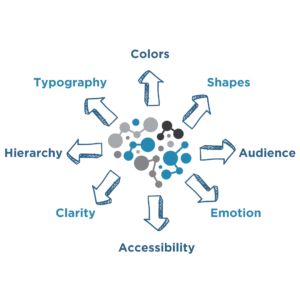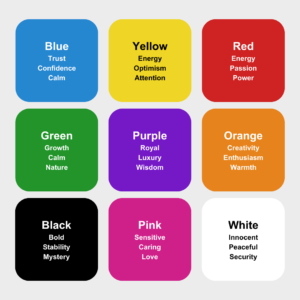The world bombards us with visual information every day. From the packaging that catches your eye at the grocery store to the website that compels you to click, graphic design plays a powerful role in shaping our behavior. But how exactly does it work its magic? Let’s delve into the fascinating intersection of graphic design and human psychology, exploring how design influences us and how to leverage that power to connect with your audience effectively, all while ensuring accessibility for everyone.
The Silent Language of Design
Graphic design isn’t just about aesthetics; it’s a form of communication that speaks directly to our subconscious. We’re wired to respond to visual cues instinctively. Colors evoke emotions, shapes guide our attention, and typography influences how we perceive information. A skilled designer understands this “silent language” and uses it to craft visuals that resonate with the target audience.
Color Psychology
“Colors are not inherently meaningful. Meaning is something we give to colors through personal experience and cultural conditioning.” (Michael Bierut). Colors have a profound impact on our moods and emotions. Red is often associated with excitement and urgency, while blue evokes feelings of trust and calmness. Green conveys a sense of nature and growth, while yellow embodies optimism and energy. By understanding color psychology, designers can use colors strategically to influence how viewers perceive a brand or message.
Shape and Hierarchy
Shapes are another powerful tool in the designer’s arsenal. Sharp angles can create a sense of urgency or danger, while curves evoke feelings of comfort and approachability. Designers use shapes to guide our eye, drawing attention to specific elements and establishing a visual hierarchy. For instance, a prominent call to action button on a website might be a bold, contrasting color and a rounded shape to encourage clicks.
Typography and Trust
The typefaces we choose also contribute to the overall message. Typography is often an overlooked element, but as design guru Ellen Lupton states in Thinking with Type, it’s the invisible art of making the written word visible. The right typeface can make information clear and engaging, while the wrong one can create confusion and hinder communication. A playful, whimsical font might be perfect for a children’s brand, while a serious, serif font would better suit a financial institution. Fonts also influence how easy it is to read and understand information. A clear, well-spaced layout with a legible font builds trust and ensures the message is received effectively.
Connecting with Your Audience
Understanding the psychology behind design allows you to connect with your audience on a deeper level. Here’s how:
- Know your audience: Who are you trying to reach? What are their needs, wants, and pain points? By tailoring your design to resonate with their specific psychology, you’ll grab their attention and hold it.
- Evoke emotions: Don’t just present information; create an emotional connection. Use visuals that evoke the feelings you want your audience to have, encouraging them to take action or engage with your brand.
- Clarity and simplicity: In today’s information-overload world, simplicity is key. Use clean layouts, concise language, and clear visuals to ensure your message is easily understood.
Accessibility for All
While we’ve focused on the psychological impact of design, it’s crucial to remember that good design is inclusive design. “Designing for accessibility is not a separate process. It’s about good design from the beginning.” (WebAIM). Here’s how to ensure your design reaches everyone:
- Color contrast: Ensure sufficient contrast between text and background colors to improve readability for people with visual impairments.
- Alt text for images: Provide alternative text descriptions for images, allowing screen readers to convey the image’s content to visually impaired users.
- Clear hierarchy and navigation: Design layouts that are easy to navigate for users with cognitive disabilities.
Conclusion
Graphic design isn’t just about making things look pretty; it’s a powerful tool that can influence our emotions, guide our behavior, and ultimately impact our decisions. By understanding the connections between design and human psychology, you can create visuals that truly resonate with your audience and leave a lasting impression. Remember, accessible design is not an afterthought; it’s an essential part of the equation for effective communication. So, the next time you encounter a well-designed logo, website, or poster, take a moment to appreciate the silent language at work!
If you are in need of creative branding and design services for your business or organization, contact Coeus Creative Group at info@coeuscreativegroup.com today!
Download this free resource here: Eye See You: How Graphic Design Speaks to Our Minds
Thinking with Type: A Critical Guide for Designers, Writers, and Editors (Ellen Lupton)
How to Use Color Effectively (Michael Bierut)
WebAIM: Web Accessibility Initiative (https://webaim.org/)



